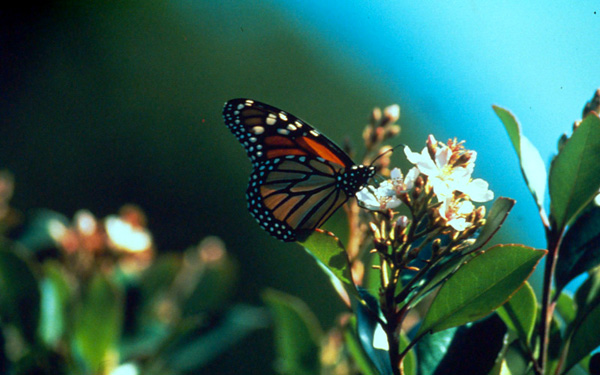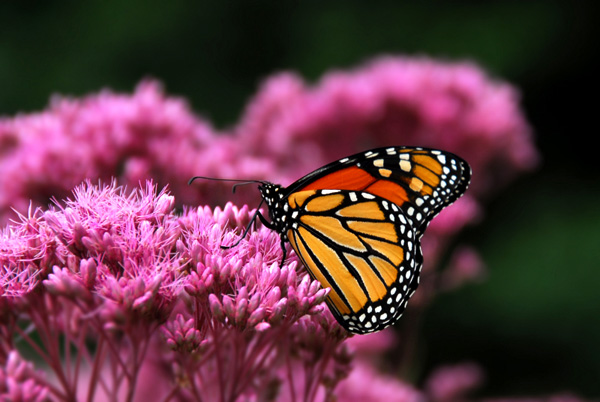Monarch conservation in the US
Do you have monarch butterfly questions? Because we have answers! To celebrate Monarch Butterfly Week (May 5-9) we will host a Google Hangout with monarch experts. Send your questions to live@wwfcanada.org today, and be sure to tune in for our live Hangout on Thursday, May 8 at 1:30 p.m. EST to get your answers!
As part of WWF’s Monarch Butterfly Week, we spoke with Dr. Karen Oberhauser and Wendy Caldwell of the Monarch Joint Venture, about efforts to support monarch breeding and migrating in the US.
What conservation efforts are in place in the US to protect monarchs?
Many key monarch conservation efforts in the US are coordinated by the Monarch Joint Venture (MJV), a partnership of 16 different programs (government and state agencies, non-profit organizations, and universities). These efforts are focused in four areas: habitat conservation and enhancement, increasing the availability of milkweed plants and seeds for large and small-scale habitat creation, supporting key research and monitoring efforts, and promoting a variety of education and outreach programs. The MJV is working to conserve both the eastern migratory population, that migrates to central Mexico each fall, and the western migratory population, that migrates to wintering sites along the California coast.

What kind of habitat do monarchs use as they migrate south through the US?
Monarchs require two key resources as they move south during the fall. They need to fuel their flight with nectar, so migratory routes must have adequate floral resources. They also need safe roosting sites, often called stopover sites, where they stop at night. These sites usually include trees, often along edges of wood lots. Some are used year after year, and others appear to host monarchs erratically from year to year. They are sometimes used over several days during the fall migration, but little is known about long an individual butterfly stays in any given site. There are some sites in the northern US where the monarch migration stopovers are monitored each year: the largest programs are in Cape May Point (NJ) and Peninsula Point (MI). Participants in the Journey North program report roost observations every fall, and these reports provide an excellent visual of monarchs’ fall migratory flight.
Check out these websites for more info:
https://www.monarchmonitoringproject.com (Cape May Point)
https://monarchnet.uga.edu/Partners/PeninsulaPoint (Peninsula Point)
https://www.learner.org/jnorth/monarch/index.html (Journey North)
Are there any particular areas that people can visit and observe monarchs?
During their migration, there are some sites, such as those in Cape May and Peninsula Point, that are predictably good places for observing monarchs in the fall. Because almost all monarchs pass through Texas on their way south, observers in that state often see large roosts, but they tend not to occur in predictable locations. During their breeding season, monarchs can be found almost anywhere there are milkweed plants; you might be able to find eggs and caterpillars on the milkweed leaves, or adults coming to visit the plants to find a mate, lay eggs, or obtain nectar!

What’s driven your enthusiasm and work to conserve the monarch butterfly?
Wendy: My passion for monarchs began during my childhood, when I became fascinated with collecting and identifying insects of all shapes and sizes. I went on to pursue a degree in environmental science and entomology and began working for Dr. Karen Oberhauser at the University of Minnesota Monarch Lab. Currently, I coordinate the national Monarch Joint Venture partnership and my passion for these insects continues to grow with every monarch success story that I hear of. I am inspired by the potential that these insects have to contribute to conservation for many things on an international scale.
Karen: I’ve been studying monarchs since 1985, and am fascinated by all aspects of their amazing biology. My focus on their conservation is driven partly by that fascination, but also by my own evolution as a conservation biologist. I believe that there are both ethical and more selfish reasons that monarchs deserve our protection. From an ethical perspective, just because we have the ability to so alter ecosystems that we can cause the extinction of species doesn’t mean that it is ethical for us to do so. Thus, preserving monarchs is the “right” thing to do. From a selfish perspective, we can learn a great deal about migration, species interactions, insect population dynamics, and insect reproduction by studying monarchs. Monarchs thus have a great deal to teach us about how the natural world works, and I would argue that understanding the natural world will benefit us. Finally, from a big picture conservation perspective, monarchs are an icon of the natural world, and provide a reason to engage with and protect nature for many people.
Learn more about these amazing species at wwfcastg.wwf.ca/monarchbutterfly. You can support WWF’s critical monarch conservation work in Mexico by making a $50 virtual gift today! You contribution will be matched by an anonymous donor in Mexico to help make double the impact.
